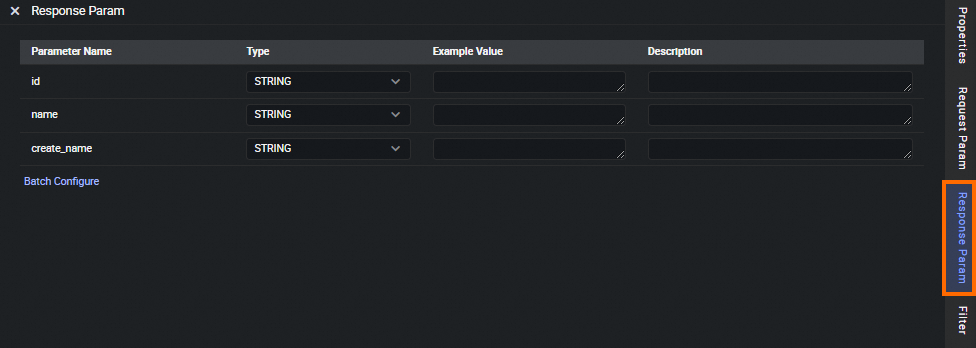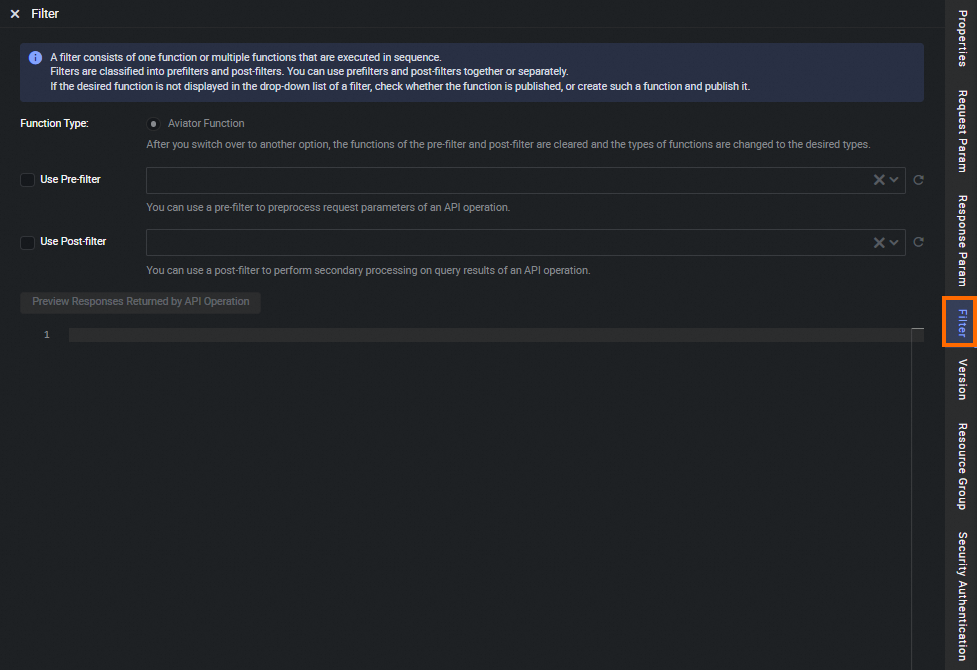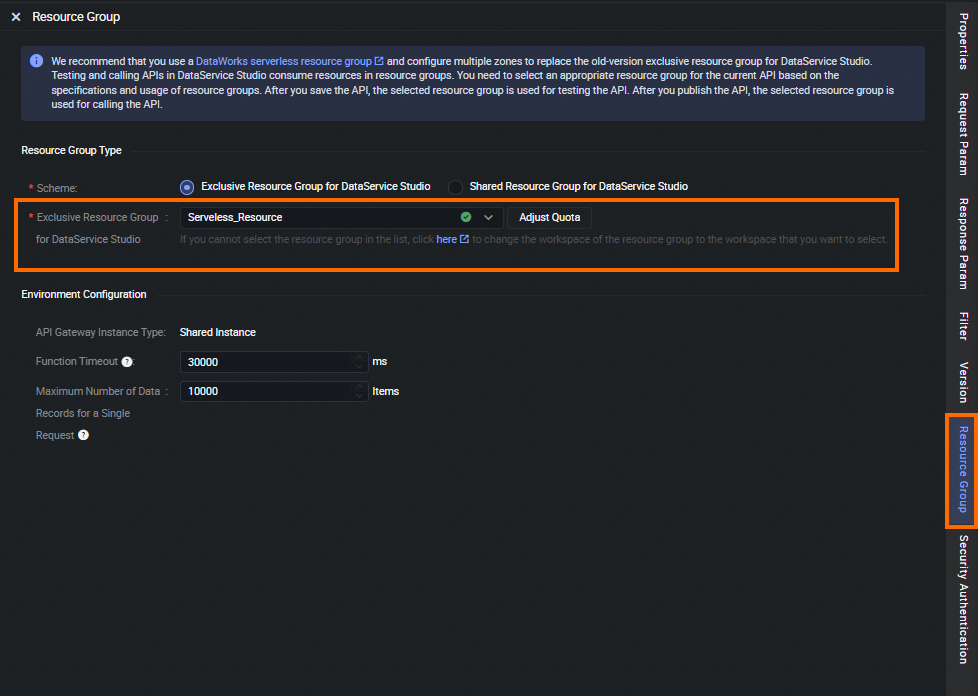DataService Studio allows you to create an API by using the codeless UI or code editor. When you use the code editor to create an API, you can customize SQL statements for the API. The code editor allows you to use table join queries, complex queries, and aggregate functions to meet your personalized query requirements. This topic describes how to create an API by using the code editor.
Prerequisites
A data source is configured on the Data Sources page. For more information, see Add a data source.
A resource group is created for DataService Studio. We recommend that you use a serverless resource group in the production environment. For more information, see Preparations.
Go to the DataService Studio page
Log on to the DataWorks console. In the top navigation bar, select the desired region. In the left-side navigation pane, choose . On the page that appears, select the desired workspace from the drop-down list and click Go to DataService Studio.
Generate an API
In the Service Development pane, move the pointer over the
 icon and choose .
icon and choose . You can also select a business process, right-click API, and then choose .
In the Generate API dialog box, configure the parameters.
Parameter
Description
API Mode
The mode that is used to create the API. Valid values: Wizard Mode and Script Mode. In this example, select Script Mode.
SQL Mode
The SQL mode. Valid values:
Basic SQL: Use basic SQL statements to implement the query logic. This mode provides the SQL capability that is the same as that in earlier versions.
Advanced SQL: Use SQL statements with MyBatis tags to implement the query logic. This mode supports the following tag types: if, choose, when, otherwise, trim, foreach, and where.
API Name
The name of the API. The name must be 4 to 50 characters in length, and can contain letters, digits, and underscores (_). The name must start with a letter.
API Path
The path of the API, such as /user.
Protocol
The protocol that is used by the API. Valid values: HTTP and HTTPS.
If you want to call the API by using HTTPS, you must bind an independent domain name to the API group to which the API belongs in the API Gateway console after the API is published to API Gateway. You must also upload an SSL certificate in the API Gateway console. For more information, see Enable HTTPS for an API operation.
Request Method
The request method. Valid values: GET and POST.
NoteIf you select GET for the Request Method parameter, you can select only QUERY for the Position parameter. If you select POST for the Request Method parameter, you can select QUERY or BODY for the Position parameter.
Response Type
The format of the data returned by the API. Set the value to JSON.
Visible Scope
The range of users to whom the API is visible. Valid values:
Workspace: The API is visible to all members in the current workspace.
Private: The API is visible only to its owner, and permissions on the API cannot be granted to other members.
NoteIf you set this parameter to Private, other members in the workspace cannot view the API in the API list.
Label
Select tags from the Label drop-down list. For more information, see Create and manage API tag.
NoteA tag can be up to 20 characters in length, and can contain letters, digits, and underscores (_). You can add at most five tags to an API.
Description
The description of the API. The description can be up to 2,000 characters in length.
Destination Folder
The folder in which you want to store the API.
Click OK.
Configure the API
1. Select a table
Double-click the API in the API list. On the tab that appears, configure the Datasource Type, Datasource Name, and Data Source Environment parameters.
The parameters that you need to configure vary based on the selected data source type. The parameters in the console prevail.
You must add a data source on the Data Source page first. You can enter a table name in the Table Name field to search for the table that you want to use.
A data source must be selected first, and table join queries are supported only in the same data source.
For a workspace in standard mode, you can select Production or Environment for the Data Source Environment parameter. For more information, see Differences between workspaces in basic mode and workspaces in standard mode.
If you select a MaxCompute table for an API, you can select Acceleration Service or MCQA for the Acceleration Method parameter for acceleration. Acceleration Service is an acceleration method provided by DataWorks and MCQA is an acceleration method provided by MaxCompute. If you select Acceleration Service, you must make sure that acceleration items are created. For more information, see Acceleration solutions for API-based data queries.
2. Write an SQL statement for querying data
In the Edit Query SQL section, write an SQL statement for querying data.
If you set the SQL Mode parameter to Basic SQL, you can write only a basic SQL statement.
 Note
NoteThe SELECT statement specifies the parameters that the API returns. The WHERE clause specifies the request parameters of the API. You must use ${} to interpolate a request parameter.
Follow the following rules when you write an SQL statement:
Single-table queries, table join queries, and nested queries are supported in the same data source.
The SQL statement must meet the following requirements:
You can write only one SQL statement.
An SQL comment is not allowed.
Only the SELECT statement is supported. Other statements such as INSERT, UPDATE, or DELETE are not supported.
The
SELECT \*statement is not supported. You must specify the columns to be queried.${param} cannot be enclosed in single quotation marks (' '). For example,
'${id}'or'abc${xyz}123'is not allowed. If necessary, you can useconcat('abc', ${xyz}, '123')instead.Parameters cannot be configured as optional.
If the name of a column that the SELECT statement specifies has a table prefix, such as t.name, you must set an alias for the corresponding response parameter. For example, you can specify t.name as name.
If you use an aggregate function, such as min, max, sum, or count, you must set an alias for the corresponding response parameter. For example, you can specify
sum(num) as total\_num.${param} in the SQL statement, including ${param} in strings, is regarded as request parameters and replaced. If an escape character (\) is placed before ${param}, ${param} is processed as a common string.
If you set the SQL Mode parameter to Advanced SQL, you can write an SQL statement with MyBatis tags.

The Advanced SQL mode supports the following types of MyBatis tags: if, choose, when, otherwise, trim, foreach, and where. You can use SQL statements with MyBatis tags to implement complex query logic, such as null parameter checking, cyclic traversal over multiple values, dynamic queries, dynamic sorting, and aggregate analysis. For more information about sample code for common scenarios, see Sample code for the advanced SQL syntax used for creating an API in the code editor.
If the written SQL statement with MyBatis tags contains special characters, you must escape the special characters. The following table describes the escape characters that correspond to the common special characters.
Special character
Escape character
Description
>
>
Greater than
>=
>=
Greater than or equal to
<
<
Less than
<=
<=
Less than or equal to
&
&
And
'
'
Single quotation mark
"
"
Double quotation mark
3. Configure the request parameters
In the right-side navigation pane, click the Request Param tab. On the Request Param tab, configure the parameters based on your business requirements.
If you set the SQL Mode parameter to Advanced SQL, you must manually add all request parameters that are specified in the SQL statement to the parameter list. This ensures that the parameters that are described in the API details are consistent with the parameters that are used.
Before you preview the result, you must configure the information such as the example value, default value, and description for each request parameter of the API.
To improve the match efficiency, specify an indexed field as a request parameter.

Parameter | Description |
Parameter Name | The name of the request parameter. The name can be up to 64 characters in length, and can contain letters, digits, underscores (_), and hyphens (-). The name must start with a letter. |
Type | The data type of the request parameter. Valid values: STRING, INT, LONG, FLOAT, DOUBLE, and BOOLEAN. |
Position | The position of the request parameter. Valid values: QUERY and BODY. Note If you set the Position parameter to BODY for one or more request parameters, you must set the Content-Type parameter to define the format of the request parameters in the request body. Valid values of Content-Type:
|
Required | Specifies whether the request parameter is required. |
Example Value | The example value of the request parameter. |
Default value | The default value of the request parameter. |
Description | The description of the request parameter. |
4. Configure the response parameters
In the right-side navigation pane, click the Response Param tab. On the Response Param tab, configure the parameters.

Configure the response parameters.
If you set the SQL Mode parameter to Advanced SQL, you must manually add all response parameters that are specified in the SQL statement to the parameter list. This ensures that the parameters that are described in the API details are consistent with the parameters that are used.
Parameter
Description
Parameter Name
The name of the response parameter. The name can be up to 64 characters in length and can contain letters, digits, underscores (_), and hyphens (-). The name must start with a letter.
Type
The data type of the request parameter. Valid values: STRING, INT, LONG, FLOAT, DOUBLE, and BOOLEAN.
Example Value
The example value of the response parameter.
Description
The description of the response parameter.
Configure the Pagination for Return Results parameter.
If you do not turn on Pagination for Return Results, the API returns up to 2,000 records by default.
If more than 2,000 records may be returned, we recommend that you turn on Pagination for Return Results. If you turn on Pagination for Return Results, you can go to the Resource Group tab to configure the Maximum Number of Data Records for a Single Request parameter based on the resource group you selected.
NoteAfter you turn on Pagination for Return Results, the number of records to return is subject to the pagination settings. If you write SQL statements to set a limit for the number of records to return in the Edit Query SQL section, the limit does not take effect.
The following common parameters are displayed when you turn on Pagination for Return Results:
Common request parameters
returnTotalNum: specifies whether to return the total number of entries for a single request.
pageNum: the number of the page to return.
pageSize: the number of entries to return on each page.
Common response parameters
pageNum: the number of the page to return.
pageSize: the number of entries to return on each page.
totalNum: the total number of entries returned.
NoteRequest parameters are optional for an API. If you do not specify request parameters for an API, you must turn on Pagination for Return Results.
5. Configure a filter
If you need to preprocess the request parameters of an API or process the results returned by an API, you can configure a filter for the API by performing the following steps: In the right-side navigation pane, click Filter. In the Filter panel, select Use Pre-filter or Use Post-filter based on your business requirements. After you configure the Function Type parameter, select one or more functions from the drop-down list next to the Use Pre-filter or Use Post-filter check box. If you select multiple functions, the functions are used to process parameters based on the sequence in which they are selected. Then, you can click Preview Responses Returned by API Operation and check whether the processing results of the selected functions meet your expectations. For more information about how to create and use a filter, see Create an Aviator function and Create a Python function.
If you want to use a Python function as a filter, you must activate DataWorks Professional Edition or a more advanced edition and use the shared resource group for DataService Studio.
If you want to use an Aviator function as a filter, all DataWorks editions are supported, but you must use an exclusive resource group for DataService Studio.
If the function that you want to use is not available in the drop-down list, check whether the function is published. If the function is not published, publish the function. Alternatively, you can create and publish a new function. For more information, see Publish a function.

6. Configure a resource group for DataService Studio
In the right-side navigation pane, click the Resource Group tab. In the Resource Group Type section, configure the Schema parameter.
You can select Exclusive Resource Group for DataService Studio or Shared Resource Group for DataService Studio for the Scheme parameter. If you select Exclusive Resource Group for DataService Studio, select an exclusive resource group from the Exclusive Resource Group for DataService Studio drop-down list. If you select Shared Resource Group for DataService Studio, you do not need to select a resource group. DataWorks automatically uses the shared resource group to generate the API.
 Note
NoteIf the resource group that you want to use is not displayed in the drop-down list, go to the Resource Groups page, find the resource group, and click Associate Workspace in the Actions column to associate the resource group with the workspace.
If the resource group that you want to use is displayed in the drop-down list but cannot be selected, go to the Resource Groups page, find the resource group, and choose in the Actions column to go to the Manage Quota dialog box. In the Manage Quota dialog box, manually configure the Occupied CUs or Minimum CUs parameter for the resource group for DataService Studio. If the billing method of the resource group is pay-as-you-go, you must configure the Occupied CUs parameter. If the billing method of the resource group is subscription, you must configure the Minimum CUs parameter.
In the Environment Configuration section, you can configure the Memory, Function Timeout, and Maximum Number of Data Records for a Single Request parameters.
The maximum value of the Function Timeout parameter varies based on the type of the resource group you select and the type of the API Gateway instance you use:
Shared API Gateway instances: The maximum value of this parameter is 30000.
Dedicated API Gateway instances: If you select Shared Resource Group for DataService Studio, the maximum value of this parameter is 30000. If you select Exclusive Resource Group for DataService Studio, the maximum value of this parameter is 90000.
NoteThe response time of the API operation depends on the actual execution time of the SQL statement. To prevent request failures caused by response timeout, configure the timeout period based on the actual execution time of the SQL statement.
The maximum value of the Maximum Number of Data Records for a Single Request parameter varies based on the type of the resource group you select:
If you select Shared Resource Group for DataService Studio, the maximum value of this parameter is 2000.
If you select Exclusive Resource Group for DataService Studio, the maximum value of this parameter is 10000.
NoteNo limits are imposed on the total number of returned results. The number of returned results is the same as the actual number of query results.
7. Save and commit the API
Click the ![]() icon in the top toolbar. After the API is saved, the selected resource group takes effect during the test.
icon in the top toolbar. After the API is saved, the selected resource group takes effect during the test.
After the API is configured, you can test the API. For more information, see Test an API.
After the test succeeds, click Submit in the upper-right corner.
In the right-side navigation pane of the API configuration tab, click Version. Find the API version that you want to publish and click Application for publication in the Actions column to go to the application page. Use the default application type Publish data service API and enter the reason for the application in the Reason for application field. Then, click Apply for permission to submit the application.
If you defined an approval policy in DataWorks Approval Center, the API must be approved before the API can be published. For more information, see Overview.
After the API is published, the configuration of the resource group for DataService Studio takes effect when the API is called.
On the Service Development tab, you can find the registered API in the left-side navigation pane and manage the API. For example, you can clone or delete the API. On the Service Management tab, you can find the published API and view the details of the published API. For more information, see View, delete, move, and clone an API, perform batch operations on multiple APIs, and use the code search feature to search for APIs.
 > > > Manage Quota
> > > Manage Quota